Choosing a Gaming CPU: Single + Multi-GPU at 1440p, April 2013
by Ian Cutress on May 8, 2013 10:00 AM ESTCPU Benchmarks
Point Calculations - 3D Movement Algorithm Test
The algorithms in 3DPM employ both uniform random number generation or normal distribution random number generation, and vary in amounts of trigonometric operations, conditional statements, generation and rejection, fused operations, etc. The benchmark runs through six algorithms for a specified number of particles and steps, and calculates the speed of each algorithm, then sums them all for a final score. This is an example of a real world situation that a computational scientist may find themselves in, rather than a pure synthetic benchmark. The benchmark is also parallel between particles simulated, and we test the single threaded performance as well as the multi-threaded performance.
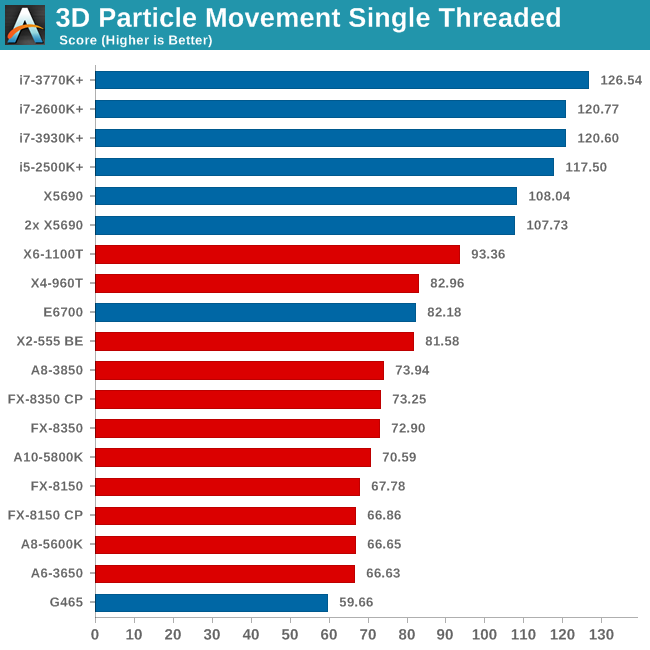
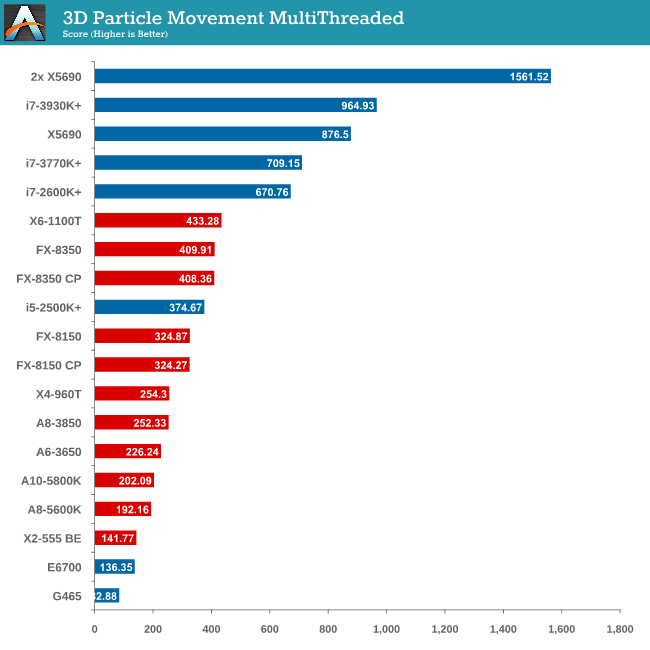
As mentioned in previous reviews, this benchmark is written how most people would tackle the situation – using floating point numbers. This is also where Intel excels, compared to AMD’s decision to move more towards INT ops (such as hashing), which is typically linked to optimized code or normal OS behavior.
Compression - WinRAR x64 3.93 + WinRAR 4.2
With 64-bit WinRAR, we compress the set of files used in our motherboard USB speed tests. WinRAR x64 3.93 attempts to use multithreading when possible and provides a good test for when a system has variable threaded load. WinRAR 4.2 does this a lot better! If a system has multiple speeds to invoke at different loading, the switching between those speeds will determine how well the system will do.
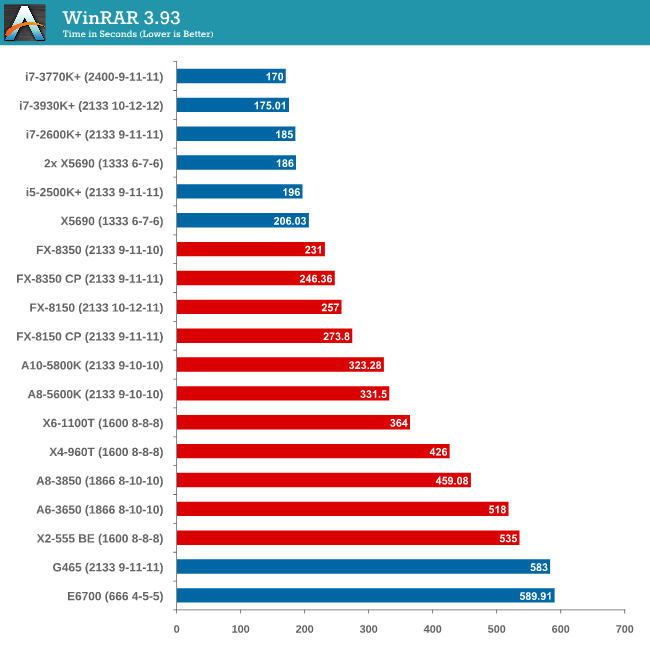

Due to the late inclusion of 4.2, our results list for it is a little smaller than I would have hoped. But it is interesting to note that with the Core Parking updates, an FX-8350 overtakes an i5-2500K with MCT.
Image Manipulation - FastStone Image Viewer 4.2
FastStone Image Viewer is a free piece of software I have been using for quite a few years now. It allows quick viewing of flat images, as well as resizing, changing color depth, adding simple text or simple filters. It also has a bulk image conversion tool, which we use here. The software currently operates only in single-thread mode, which should change in later versions of the software. For this test, we convert a series of 170 files, of various resolutions, dimensions and types (of a total size of 163MB), all to the .gif format of 640x480 dimensions.
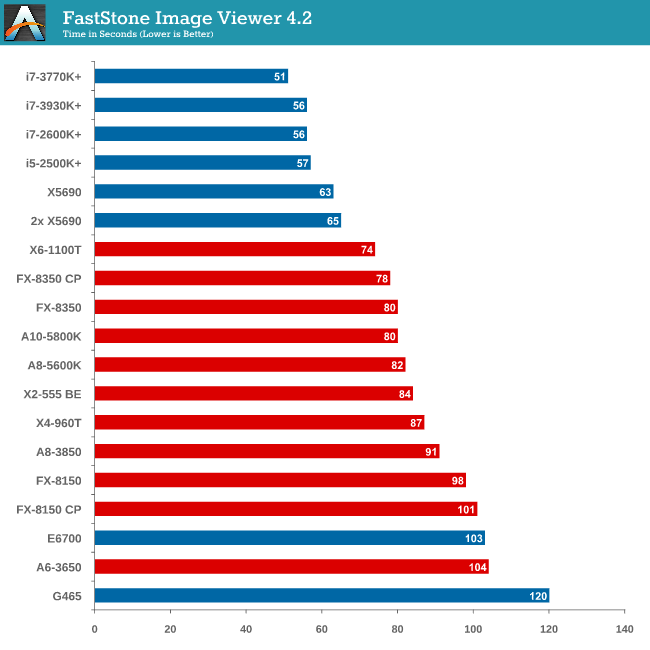
In terms of pure single thread speed, it is worth noting the X6-1100T is leading the AMD pack.
Video Conversion - Xilisoft Video Converter 7
With XVC, users can convert any type of normal video to any compatible format for smartphones, tablets and other devices. By default, it uses all available threads on the system, and in the presence of appropriate graphics cards, can utilize CUDA for NVIDIA GPUs as well as AMD WinAPP for AMD GPUs. For this test, we use a set of 33 HD videos, each lasting 30 seconds, and convert them from 1080p to an iPod H.264 video format using just the CPU. The time taken to convert these videos gives us our result.
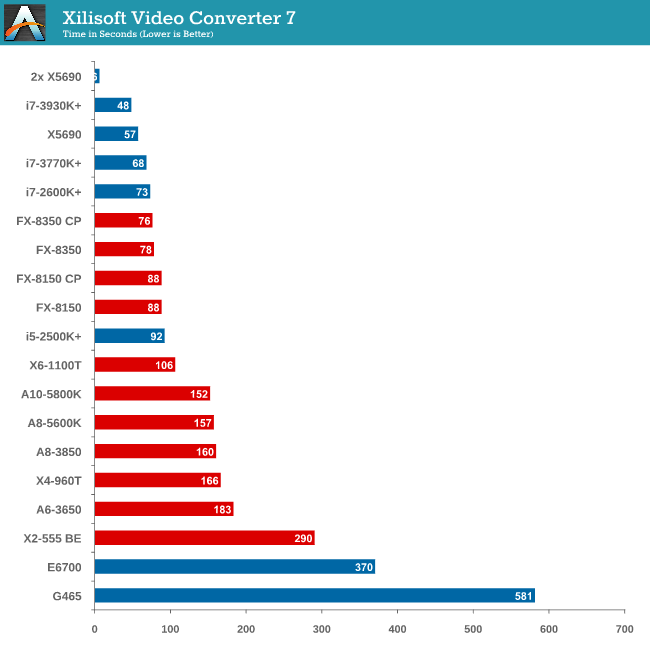
XVC is a little odd in how it arranges its multicore processing. For our set of 33 videos, it will arrange them in batches of threads – so if we take the 8 thread FX-8350, it will arrange the videos into 4 batches of 8, and then a fifth batch of one. That final batch will only have one thread assigned to it (!), and will not get a full 8 threads worth of power. This is also why the 2x X5690 finishes in 6 seconds but the normal X5690 takes longer – you would expect a halving of time moving to two CPUs but XVC arranges the batches such that there is always one at the end that only gets a single thread.
Rendering – PovRay 3.7
The Persistence of Vision RayTracer, or PovRay, is a freeware package for as the name suggests, ray tracing. It is a pure renderer, rather than modeling software, but the latest beta version contains a handy benchmark for stressing all processing threads on a platform. We have been using this test in motherboard reviews to test memory stability at various CPU speeds to good effect – if it passes the test, the IMC in the CPU is stable for a given CPU speed. As a CPU test, it runs for approximately 2-3 minutes on high end platforms.
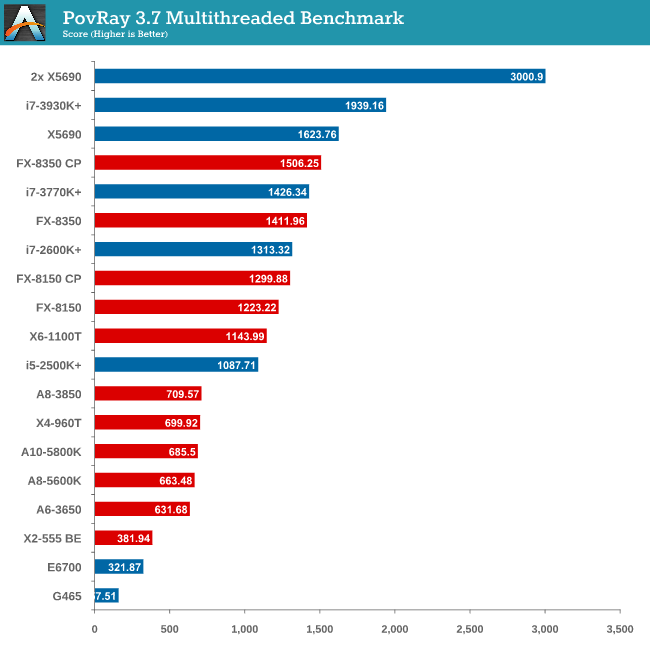
The SMP engine in PovRay is not perfect, though scaling up in CPUs gives almost a 2x effect. The results from this test are great – here we see an FX-8350 CPU below an i7-3770K (with MCT), until the Core Parking updates are applied, meaning the FX-8350 performs better!
Video Conversion - x264 HD Benchmark
The x264 HD Benchmark uses a common HD encoding tool to process an HD MPEG2 source at 1280x720 at 3963 Kbps. This test represents a standardized result which can be compared across other reviews, and is dependent on both CPU power and memory speed. The benchmark performs a 2-pass encode, and the results shown are the average of each pass performed four times.
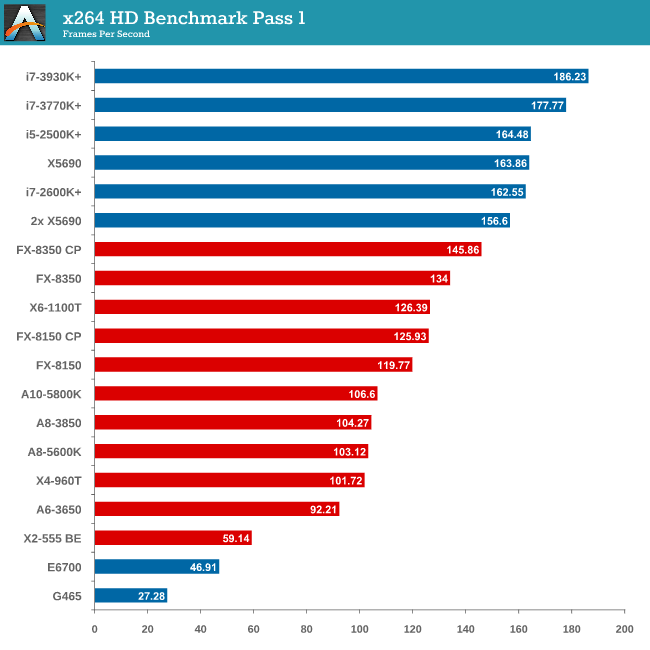
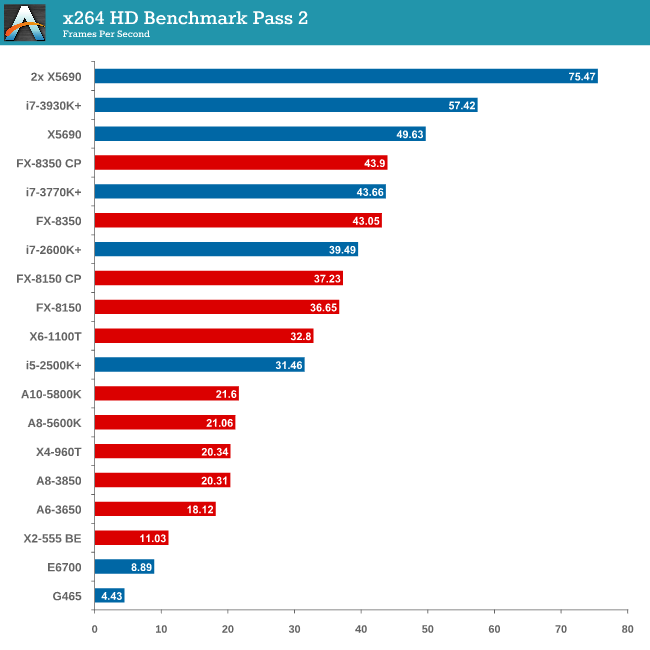
Grid Solvers - Explicit Finite Difference
For any grid of regular nodes, the simplest way to calculate the next time step is to use the values of those around it. This makes for easy mathematics and parallel simulation, as each node calculated is only dependent on the previous time step, not the nodes around it on the current calculated time step. By choosing a regular grid, we reduce the levels of memory access required for irregular grids. We test both 2D and 3D explicit finite difference simulations with 2n nodes in each dimension, using OpenMP as the threading operator in single precision. The grid is isotropic and the boundary conditions are sinks. Values are floating point, with memory cache sizes and speeds playing a part in the overall score.
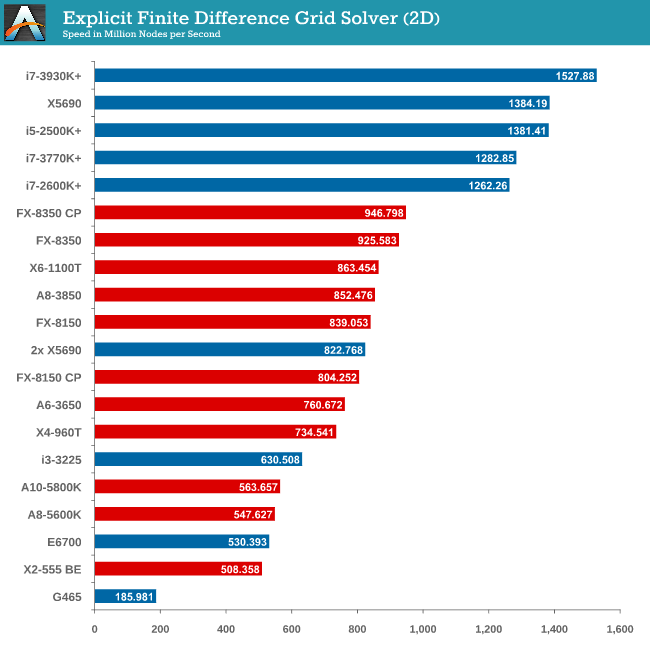
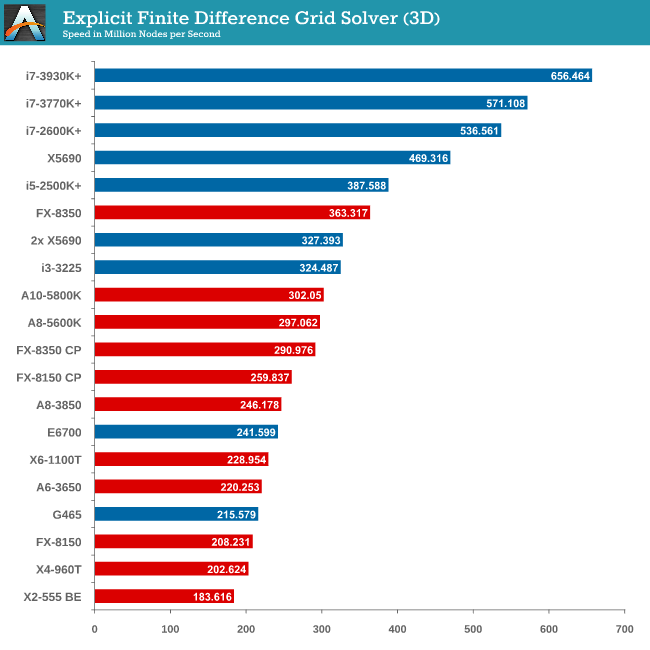
Grid solvers do love a fast processor and plenty of cache in order to store data. When moving up to 3D, it is harder to keep that data within the CPU and spending extra time coding in batches can help throughput. Our simulation takes a very naïve approach in code, using simple operations.
Grid Solvers - Implicit Finite Difference + Alternating Direction Implicit Method
The implicit method takes a different approach to the explicit method – instead of considering one unknown in the new time step to be calculated from known elements in the previous time step, we consider that an old point can influence several new points by way of simultaneous equations. This adds to the complexity of the simulation – the grid of nodes is solved as a series of rows and columns rather than points, reducing the parallel nature of the simulation by a dimension and drastically increasing the memory requirements of each thread. The upside, as noted above, is the less stringent stability rules related to time steps and grid spacing. For this we simulate a 2D grid of 2n nodes in each dimension, using OpenMP in single precision. Again our grid is isotropic with the boundaries acting as sinks. Values are floating point, with memory cache sizes and speeds playing a part in the overall score.
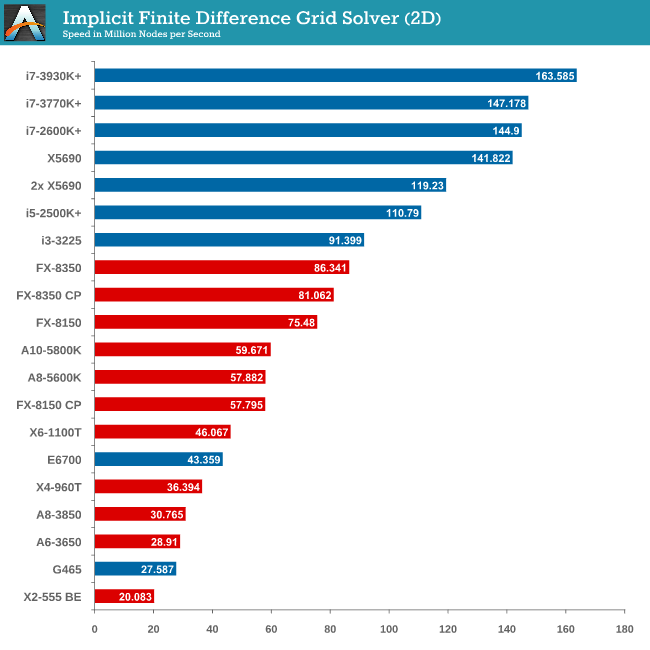
2D Implicit is harsher than an Explicit calculation – each thread needs more a lot memory, which only ever grows as the size of the simulation increases.
Point Calculations - n-Body Simulation
When a series of heavy mass elements are in space, they interact with each other through the force of gravity. Thus when a star cluster forms, the interaction of every large mass with every other large mass defines the speed at which these elements approach each other. When dealing with millions and billions of stars on such a large scale, the movement of each of these stars can be simulated through the physical theorems that describe the interactions. The benchmark detects whether the processor is SSE2 or SSE4 capable, and implements the relative code. We run a simulation of 10240 particles of equal mass - the output for this code is in terms of GFLOPs, and the result recorded was the peak GFLOPs value.
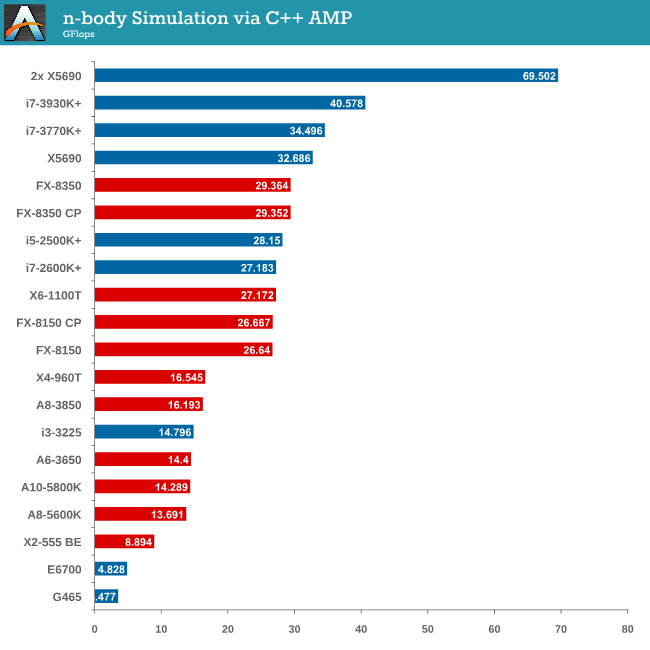
As we only look at base/SSE2/SSE4 depending on the processor (auto-detection), we don’t see full AVX numbers in terms of FLOPs.










242 Comments
View All Comments
TheQweaker - Friday, May 10, 2013 - link
Just in case, here is a pointer to the nVidia GPU AI Path finding in the developer zone:https://developer.nvidia.com/gpu-ai-path-finding
And here is the title of a 2011 GPU AI Planning paper (research; not yet in a game): "Exploiting the Computational Power of the Graphics Card: Optimal State Space Planning on the GPU". You should be able to find the PDF on the web.
My 2 cents is that it's a good topic for a final paper.
-- The Qweaker.
yougotkicked - Friday, May 10, 2013 - link
Thanks again, I think I will be doing GPU AI as my final paper, probably try to implement the A* family as massively parallel, or maybe a local beam search using hundreds of hill-climbing threads.TheQweaker - Saturday, May 11, 2013 - link
Nice project.2 more cents.
Keep it simple is the best advice. It's better to have a running algorithm than none, even if it's slow.
Also, ask you advisor whether he'd want you to compare with a CPU implementation of yours in order to evaluate the pros and cons between your sequential implementation and your // implemenation. I did NOT write "evaluate gains from seq to //" as GPU programming is currently not fully understood, probably even not by nVidia engineers.
Finally, here is book title: "CUDA Programming: A Developer's Guide to Parallel Computing with GPUs". But there are many others these days.
OK. That w
TheQweaker - Saturday, May 11, 2013 - link
as my last post.-- The Qweaker.
(sorry for the cut, I wrongly clicked on submit)
yougotkicked - Monday, May 13, 2013 - link
thanks a lot for all your input, I intend to evaluate not only the advantages of GPU computing, but it's weak points as well, so I'll be sure to demonstrate the differences between a sequential algorithm, a parallel CPU algorithm, and a massively parallel GPU algorithm.Azusis - Wednesday, May 8, 2013 - link
Could you test the Q6600 and i7-920 in your next roundup? I have many PC gaming friends, and we all seem to have a Q6600, i7-920, or 2500k in our rigs. Thanks! Great job on the article.IanCutress - Wednesday, May 8, 2013 - link
I have a Q9400 coming in soon from family - Getting one of the Nehalem/Westmere range is definitely on my to-do list for the next update :)sonofgodfrey - Thursday, May 9, 2013 - link
I too have a Q6600, but it would be interesting to see the high end (non-extreme edition) Core 2s as well: E8600 & Q9650. Just for yucks, perhaps a socket 775 Pentium 4 could also make an appearance? :)gonks - Wednesday, May 8, 2013 - link
i knew it from some time ago, but this proves once again that it's time to upgrade my good old c2d (conroe) E6600 @ 3.2GhzQuizzical - Wednesday, May 8, 2013 - link
You've got a lot of data there. And it's good data if your main purpose is to compare a Radeon HD 7970 to a GeForce GTX 580. Unfortunately, most of it is worthless if you're trying to isolate CPU performance, which is the ostensible purpose of the article. You've gone far out of your way to try to make games GPU-limited so that you wouldn't be able to tell what the various CPUs can do when they're the main limiting factors.Loosely, the CPU has to do any work to run a game that isn't done by the GPU. The contents of this can vary wildly from game to game. Unless you're using DirectX 11 multithreaded rendering, only one thread can communicate with the video card at a time. But that one rendering thread mostly consists of passing data to the video card, so you don't do much in the way of real computations there. You do sort some things so that you don't have to switch programs, textures, and so forth more often than necessary, though you can have a separate sorting thread if you're (probably unreasonably) worried that this is going to mean too much work for the rendering thread.
Actually determining what data needs to be passed to the video card can comprise the bulk of the CPU work that a game needs to do. But this portion is mostly trivial to scale to as many threads as you care to--at least within reason. It's a completely straightforward producer-consumer queue with however many "producer" threads you want and the rendering thread as the single "consumer" thread that takes the data set up by other threads and passes it along to the video card.
Not quite all of the work of setting up data for the GPU is trivial to break into as many threads as necessary, though. At the start of a new frame, you have to figure out exactly where the camera is going to go in that frame. This is likely going to be very fast (e.g., tens or hundreds of microseconds), but it does need to be done before you go compute where everything else is relative to the camera.
While I haven't programmed AI, I'd expect that you could likewise break it up into as many threads as you cared to, as you could "save" the state of the game at some instant in time and have separate threads compute what all AI has to do based on the state of the game at that moment, without needing to know anything about other game characters were choosing at the same time. Some games are heavy on AI computations, while online games may do essentially no AI computations client-side, so this varies wildly from game to game.
A game engine may do a lot of other things besides these, such as processing inputs, loading data off of the hard drive, sending data over the Internet, or whatever. Some such things can't be readily scaled to many CPU cores, but if you count by CPU work necessary, few games will have all that much stuff to do other than setting up data for the GPU and computing AI.
But most of the work that a CPU has to do doesn't care what graphical settings you're using. Anything that isn't part of the graphics engine certainly doesn't care. The only parts of a the CPU side of game engine that care what monitor resolution you're using are likely to be a handful of lines to set the resolution when you change it and a few lines to check whether an object is off the camera and therefore doesn't need to be processed in that particular frame--and culling such objects is likely done mostly to save on the GPU load. Any settings that can be adjusted in video drivers (e.g., anti-aliasing or anisotropic filtering) are done almost entirely on the video card and carry a negligible CPU load.
Thus, if you're trying to isolate CPU performance, you turn down or off settings that don't affect the CPU load. In particular, you want a very low monitor resolution, no anti-aliasing, no anisotropic filtering, and no post-processing effects of any sort. Otherwise, you're just trying to make the game mostly CPU bound, and end up with data that looks like most of what you've collected.
Furthermore, even if you do the measurements properly, there's also the question of whether the games you've chosen are representative of what most people will play. If you grab the games that you usually benchmark for video cards reviews, then you're going out of your way to pick games that are unrepresentative. Tech sites like this that review hardware tend to gravitate toward badly-coded games that aren't representative of most of the games that people will play. If this video card gets 200 frames per second at max settings in one game and that video card gets 300, what's the difference in real-world game experience? If you want to differentiate between different video cards, you need games that are more demanding, and simply being really inefficient is one way to do that.
Of course, if you were trying to see how different CPUs affect performance in a mostly GPU-limited game, that can be interesting in an esoteric sense. It would probably tend to favor high single-threaded performance because the only difference you'd be able to pick out are due to things that happen between frames, which is the time that the video card is most likely to be forced to wait on the CPU briefly.
But if you were trying to do that, why not just use a Radeon HD 5450? The question answers itself.
If you would like to get some data that will be more representative of how games handle CPUs, then you'll need to do some things very differently. For starters, use just a single powerful GPU, to avoid any CrossFire or SLI weirdness. A GeForce GTX Titan is ideal, but a Radeon HD 7970 or GeForce GTX 680 would be fine. For that matter, if you're not stupid about picking graphical settings, something weaker like a Radeon HD 7870 or GeForce GTX 660 would probably work just fine. But you need to choose the graphical settings intelligently, by turning down or off any graphical settings that don't affect CPU load. In particular, anti-aliasing, anisotropic filtering, and all post-processing effects should be completely off. Use a fairly low monitor resolution; certainly no higher than 1920x1080, and you could make a good case for 1366x768.
And then don't pick your usual set of games that you use to do video card reviews. You chose those games precisely because they're outliers that won't give a good gauge of CPU performance, so they'll sabotage your measurements if you're trying to isolate CPU performance. Rather, pick games that you rejected from doing video card reviews because they were unable to distinguish between video cards very well. If the results are that in a typical game, this processor can deliver 200 frames per second and that one can do 300, then so be it. If a Core i7-3570K and an FX-6300 can deliver hundreds of frames per second in most games (as is likely if the game runs well on, say, a 2 GHz Core 2 Duo), then you shouldn't shy away from that conclusion.